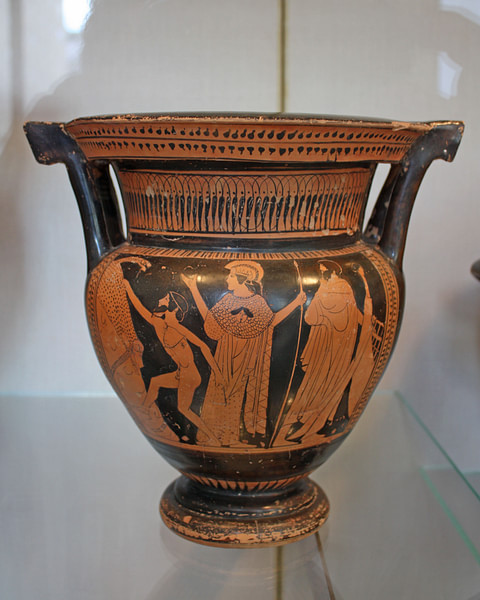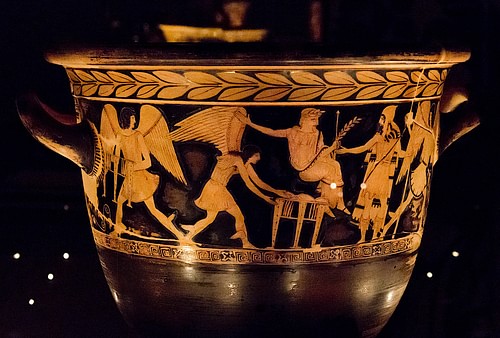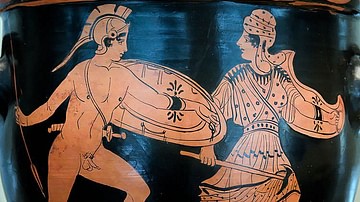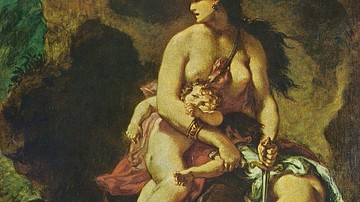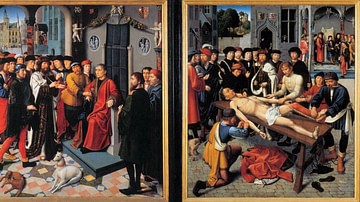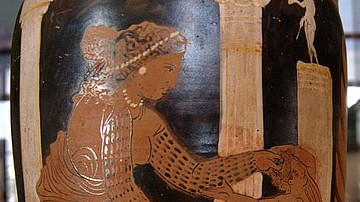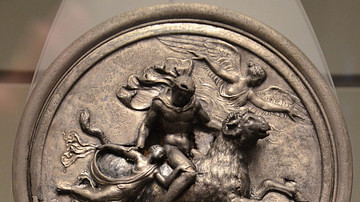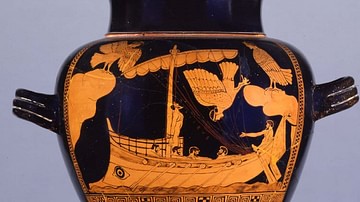The pan-Hellenic mythological hero Jason was famed for his expedition with the Argonauts - as the sailors on their ship the Argo were known - in search of the Golden Fleece in Kolchis on the Black Sea, one of the most popular and enduring legends of Greek mythology. The myth may reflect historical expeditions made by the Mycenaeans in the 13th century BCE as they explored lands to the east of the Greek world.
Jason's Youth
Jason was believed to have been educated by the wise centaur Cheiron in the forests of Mount Pelion. He had been placed under the centaur's care by his father Aison whose younger brother Pelias had usurped the throne of Iolkos in Thessaly. When he reached manhood, Jason participated in the celebrated hunt for the Kalydonian Boar which involved many Greek heroes such as Theseus, the Dioskouroi, Atalanta, and Meleager. This huge creature terrorized the city of Kalydon and the surrounding area in Aetolia, having been sent by the goddess Artemis in order to punish Oineus, Meleager's father, for his impiety in not sacrificing to the goddess.
At the age of 20, Jason finally returned to Iolkos to claim his kingdom. On his return journey Jason somehow lost one of his sandals and when he re-entered the city, Pelias saw him and recalled an oracle some years before which had declared that Pelias would lose his life at the hands of a one-sandaled man. Identifying Jason as the oracle's man, he decided to send the hero on an impossibly difficult and probably fatal expedition to bring the fabled Golden Fleece to Iolkos.
The Golden Fleece
The Golden Fleece came from a winged ram originally belonging to the god Hermes. The ram was sent by the goddess Nephele to rescue her children Phrixos and Helle from being sacrificed after Ino, their jealous step-mother, turned the people of Thebes against them. Saved just in time, the ram flew off over the sea with Phrixos and Helle. Unfortunately, during the flight, the latter fell off the ram into the sea and the place she landed - the modern straits of the Dardanelles - was thereafter called the Hellespont. Phrixos, however, was safely taken to Kolchis on the Black Sea and in thanks to the gods, he promptly sacrificed the ram and placed its golden fleece in the sacred grove of the god Ares where a fearsome serpent was set to guard it.
The Argo
Jason was a favourite with the goddess Athena and it was she who gave the first help to the expedition by having the great craftsman Argo build a strong fast boat to take the hero across the seas to Kolchis. The ship, reportedly the first Greek long ship, was named after its maker and even contained a plank of sacred wood with the power of speech, taken from the sanctuary of Zeus at Dodona. The Argo could carry 50 oarsmen and Jason filled the boat with an all-star crew of Greek heroes. Among the more famous were Hercules from Boeotia, the Dioskouroi twins from Sparta, Meleager from Kalydon, Peleus from Thessaly, Amphiaraos from Argos, Kalais and Zetes the sons of Boreas (the North Wind), and Orpheus from Thrace.
On their voyage to Kolchis the Argonauts had many adventures. One of the more notable was the rescue of Phineus from the Harpies at Salmydessos in Thrace. These terrible winged creatures had been sent by Zeus to torment the blind Phineus as punishment for blinding his own sons on the advice of their scheming step-mother. Zetes and Kalais, themselves winged, chased away or killed the Harpies thus earning the gratitude of Phineus who gave them favourable winds and advice on the best route to Kolchis. Other diversions occurred on the island of Lemnos where the female inhabitants sought to ensnare the heroes, on the island of the Doliones where they were attacked by savage giants, and on the island of the Mysians where Hercules was lost to the expedition as he searched for his lover Hylas, taken by the water nymphs.
Kolchis & King Aietes
On finally reaching Kolchis, Aietes the king, perhaps understandably, would not hand over the fleece to Jason without a struggle. Instead, he promised Jason the fleece only if he performed some particularly difficult and dangerous tasks. These were to plough a field using two fire-breathing bulls and to sow the teeth of a serpent in the field, and then fight the giants which sprang up from the magical teeth. Fortunately, Jason was assisted by Medea, the daughter of Aietes. Once again, Athena had intervened and sent Eros to make Medea fall in love with the hero. Medea was knowledgeable in magic, and she gave Jason a magic lotion to protect him from the fire-breathing bulls and advised him to throw a stone amongst the giants so that they would fight each other.
Despite successfully completing the tasks, Aietes still refused to give Jason the fleece and even attempted to burn the Argo. However, Medea showed Jason the location of the sacred grove and gave him another potion to drug the serpent that guarded the Golden Fleece. Taking the fleece back to the Argo, Jason was pursued by the king's soldiers but Medea delayed them (even killing her brother Apsyrtus in the process) and she fled Kolchis with the heroes.
The Voyage Home
The voyage back home to Iolkos was as protracted as the voyage out and the heroes once more had many adventures. A notable episode is the encounter with Talos, the bronze man given to King Minos by Hephaistos, and who ran around the island of Crete three times each day keeping guard. Talos tried to prevent the Argonauts from landing and so incurred the wrath of Medea who brought his downfall with one of her magic potions.
On the heroes' triumphant return to Iolkos, despite being given the Golden Fleece, Pelias refused to give up his throne, and it was discovered that Pelias had even conspired to kill Jason's father, Aison, whilst the hero had been away. Medea then made another magic potion, this time to convince the daughters of Pelias that if they cut up their father and boiled him in the potion, he would gain everlasting youth. This they did and, of course, it was the end of Pelias, but Jason did not become king, instead, he established Pelias' son Akastos as ruler. Jason, after marrying Medea, left to settle in Corinth which had been inherited by Aietes from his father Helios. The couple had three sons and lived happily for ten years until Jason became captivated by the charms of Glauke, daughter of Kreon, the king of Corinth. In jealous revenge, Medea killed both Glauke (with a poisoned robe and crown) and her own children and fled to Athens, in some accounts in a flying chariot pulled by dragons. This tragic end to the myth is the subject of Euripides tragedy Medea.
Links With Reality
The myth of Jason and the Golden Fleece may have been an explanation of early Greek expeditions into the East around the 13th century BCE, when the Mycenaean civilization was at its peak. The tale also has similarities to a Hittite myth involving a fleece and the god Telipinu. A third connection with the East is the historical evidence suggesting that the area of Kolchis near the Caucasus Mountains was one rich in gold, often panned from rivers using sheepskins.
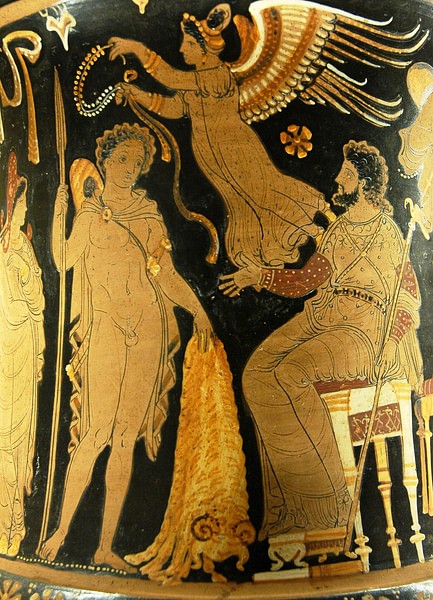
The Myth in Greek Art
The myths involving Jason were popular subjects in ancient Greek art. The antiquity of the subject is demonstrated by a scene on a Corinthian alabastron as early as the 7th century BCE. The earliest depiction of the Argo comes from a fragmentary metope from the Treasury of the Sicyonians at Delphi, c. 570 BCE. The presence of various scenes from the myths on Attic, Laconian, Corinthian, Chalcidian, and Southern Italian pottery throughout the 5th and 6th centuries BCE and the re-telling of the tale in the Argonautica by Apollonius of Rhodes in the 3rd century BCE are evidence of the far-reaching and long-lasting appeal of this truly pan-Hellenic hero.
